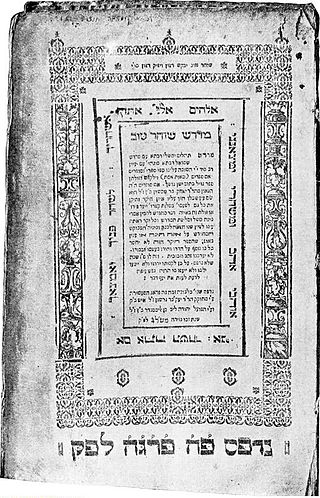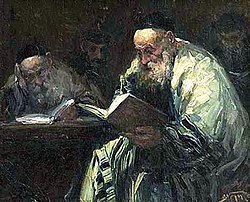
The Mishnah or the Mishna is the first major written collection of the Jewish oral traditions that are known as the Oral Torah. It is also the first major work of rabbinic literature, with the oldest surviving material dating to the 6th to 7th centuries CE.

Midrash is expansive Jewish Biblical exegesis using a rabbinic mode of interpretation prominent in the Talmud. The word itself means "textual interpretation", "study", or "exegesis", derived from the root verb darash (דָּרַשׁ), which means "resort to, seek, seek with care, enquire, require".

Rabbinic literature, in its broadest sense, is the entire spectrum of works authored by rabbis throughout Jewish history. The term typically refers to literature from the Talmudic era, as opposed to medieval and modern rabbinic writings. It aligns with the Hebrew term Sifrut Chazal, which translates to “literature [of our] sages” and generally pertains only to the sages (Chazal) from the Talmudic period. This more specific sense of "Rabbinic literature"—referring to the Talmud, Midrashim, and related writings, but hardly ever to later texts—is how the term is generally intended when used in contemporary academic writing. The terms mefareshim and parshanim almost always refer to later, post-Talmudic writers of rabbinic glosses on Biblical and Talmudic texts.

A beth midrash, also beis medrash or beit midrash, is a hall dedicated for Torah study, often translated as a "study hall". It is distinct from a synagogue, although the two are often coextensive. In Yiddish the beth midrash may be referred to as a zal, i.e. "hall". Beis midrash can also refer to a yeshiva gedolah, the undergraduate-level program in Orthodox, for boys over 12th grade.

Aggadah is the non-legalistic exegesis which appears in the classical rabbinic literature of Judaism, particularly the Talmud and Midrash. In general, Aggadah is a compendium of rabbinic texts that incorporates folklore, historical anecdotes, moral exhortations, and practical advice in various spheres, from business to medicine.
Kiddush HaShem is a precept of Judaism. In rabbinic sources and modern parlance, it refers to private and communal conduct that reflects well, instead of poorly, on the Jewish people.

Midrash Tanhuma, also known as Yelammedenu, is the name given to a homiletic midrash on the entire Torah, and it is known in several different versions or collections. Tanhuma bar Abba is not the author of the text but instead is a figure to whom traditions are frequently attributed to, though he may have preserved a collection of midrashim used by other midrash editors. The name Yelammedenu derives from the Hebrew phrase yelammedenu rabbenu, which initiates a typical textual unit in the text.
According to the biblical book of Esther, Memucan was one of the seven vice-regents of the Persian King Ahasuerus.

The Yalkut Shimoni, or simply Yalkut, is an aggadic compilation on the books of the Hebrew Bible. It is a compilation of older interpretations and explanations of Biblical passages, arranged according to the sequence of those portions of the Bible to which they referred.

The Midrash on Lamentations is a midrashic commentary to the Book of Lamentations.

A number of midrashim exist which are smaller in size, and generally later in date, than those dealt with in the articles Midrash Haggadah and Midrash Halakah. Despite their late date, some of these works preserve material from the Apocrypha and Philo of Alexandria. These small works, were in turn used by later larger works, such as Sefer haYashar (midrash). Important editors and researchers of this material include Abraham ben Elijah of Vilna, Adolf Jellinek, and Solomon Aaron Wertheimer.

Esther Rabbah is a midrash to the Book of Esther.

Yalkut haMachiri is a work of midrash. Its author was Machir ben Abba Mari, but his country and the period in which he lived are not definitively known. Moritz Steinschneider says that Machir lived in Provence; but his date remains a subject of discussion among modern scholars. Strack & Stemberger (1991) say that the work was most probably composed in the late 13th or 14th century.

Allusions in rabbinic literature to the Biblical character of Haman, the anti-Jewish villain of the Book of Esther, contain various expansions, elaborations and inferences beyond what is presented in the text of the Bible itself.

Esther was the chief character in the Book of Esther. She is counted among the prophetesses of Israel. Allusions in rabbinic literature to the Biblical story of Esther contain various expansions, elaborations and inferences beyond the text presented in the book of the Bible.
Jewish folklore are legends, music, oral history, proverbs, jokes, popular beliefs, fairy tales, stories, tall tales, and customs that are the traditions of Judaism. Folktales are characterized by the presence of unusual personages, by the sudden transformation of men into beasts and vice versa, or by other unnatural incidents. A number of aggadic stories bear folktale characteristics, especially those relating to Og, King of Bashan, which have the same exaggerations as have the lügenmärchen of modern German folktales.
Rav Giddel was a second generation Amora sage of Babylon and the Land of Israel.
Rabbi Isaac Nappaha, or Isaac the smith, was a rabbi of the 3rd-4th centuries who lived in the Galilee.
Abba Gorion of Sidon was a tanna in the second century CE. He handed down sayings from both Abba Saul and Rabban Gamaliel II. The quote from Gamaliel, was used in the introduction to a Midrash on the Book of Esther, for which reason the latter was called Midrash Abba Gorion.



